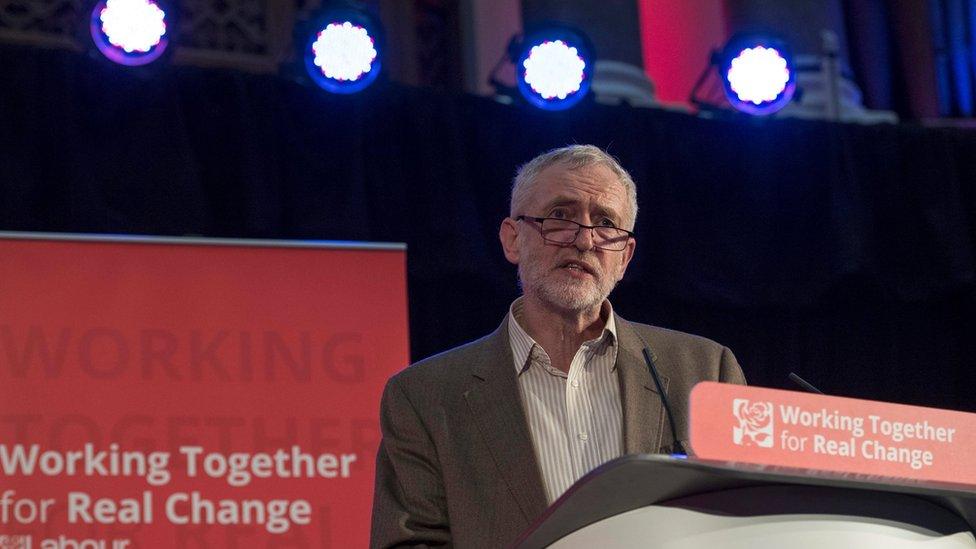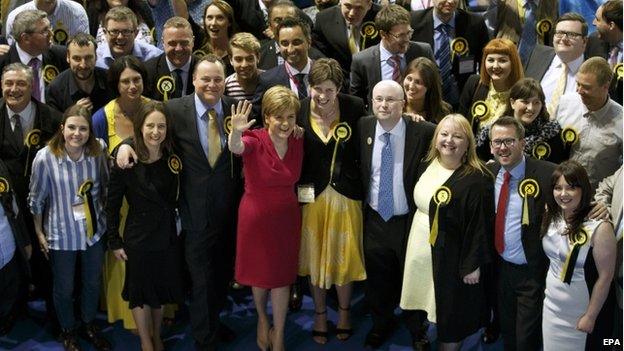Why most Labour MPs could survive vote share drop
- Published

Labour's opinion poll rating is at its lowest since 1983 but that doesn't mean it's on course to lose most of its seats.
A study , externalpublished by the Fabian Society has looked at how many seats Labour could lose at a general election if it performed in line with recent opinion polls which have put it as low as 24%, compared with 31% at the general election. The analysis suggested a loss of around 40 seats compared with 2015, when it won 232.
The calculation assumes a uniform swing across all constituencies in Britain.
If the study had included the most up-to-date polls, the figure would have been a little bit lower - perhaps around 25 to 30 Labour losses.
Either way, one interesting question is why the number isn't higher.
Len McCluskey, head of the Unite union and one of Jeremy Corbyn's strongest backers, says the current performance is "awful".
Yet the figures suggest that despite the current low standing, a large majority of Labour MPs would be re-elected.
That's because a lot of them are in safe seats.
Safely does it
An interesting feature of recent British electoral politics is that the number of safe seats has increased whereas the number of marginal seats has fallen.
It's interesting to compare the 2015 election with 1992, the last time the Conservatives won an overall majority.
In 1992, 169 of the seats in Great Britain were won with majorities under 10% - a common definition of a marginal seat. In 2015, that number was just 119. And only 49 of those were won by Labour.
On the other hand, the number of very safe seats has increased. In 1992, there were 155 seats won with majorities above 30%. In 2015, there were 223.
The electorate has become more geographically polarised.

Labour lost some previously safe seats to the SNP in 2015
A further interesting quirk of British elections is that the extremely safe seats in the country tend to be Labour seats, even when it loses the national vote.
The 11 safest seats in the country are all Labour - as are 17 of the safest 20.
That doesn't mean those constituencies could never elect an MP from another party. In 2015, Labour lost some very safe seats in Scotland as a result of the SNP landslide. But it does mean that for many Labour MPs, even the current polls shouldn't cause them too many worries about their own futures.
This trend became even more acute in 2015.
The Conservatives pulled off their surprise victory by winning votes just where they needed them, such as in Liberal Democrat-held seats in the south west of England - which is now almost entirely blue.
Meanwhile in safe Tory seats, they gained few votes.
On the other hand, Labour piled up lots of extra votes in seats it already held comfortably.
So nationally their vote share went up even as they lost seats overall.
Flipside
In the political science jargon, the Conservative vote has become more "efficient", with fewer votes wasted, while Labour's is more inefficient.
So Labour could lose quite a lot of those votes without seeing a particularly dramatic reduction in its number of seats.
The flipside of this for Labour is that fewer marginal seats also means the swing it would need to win an overall majority of its own is much higher than it would have been in the past.
Analysis by polling expert John Curtice suggests that Labour needs a national swing of nearly 10% to win a majority.
Swings of that size don't come around very often. Tony Blair managed it in 1997 as did Clement Attlee in 1945, albeit in unusual circumstances.
And the mountain will be even higher for Labour if and when the proposed boundary changes are implemented.